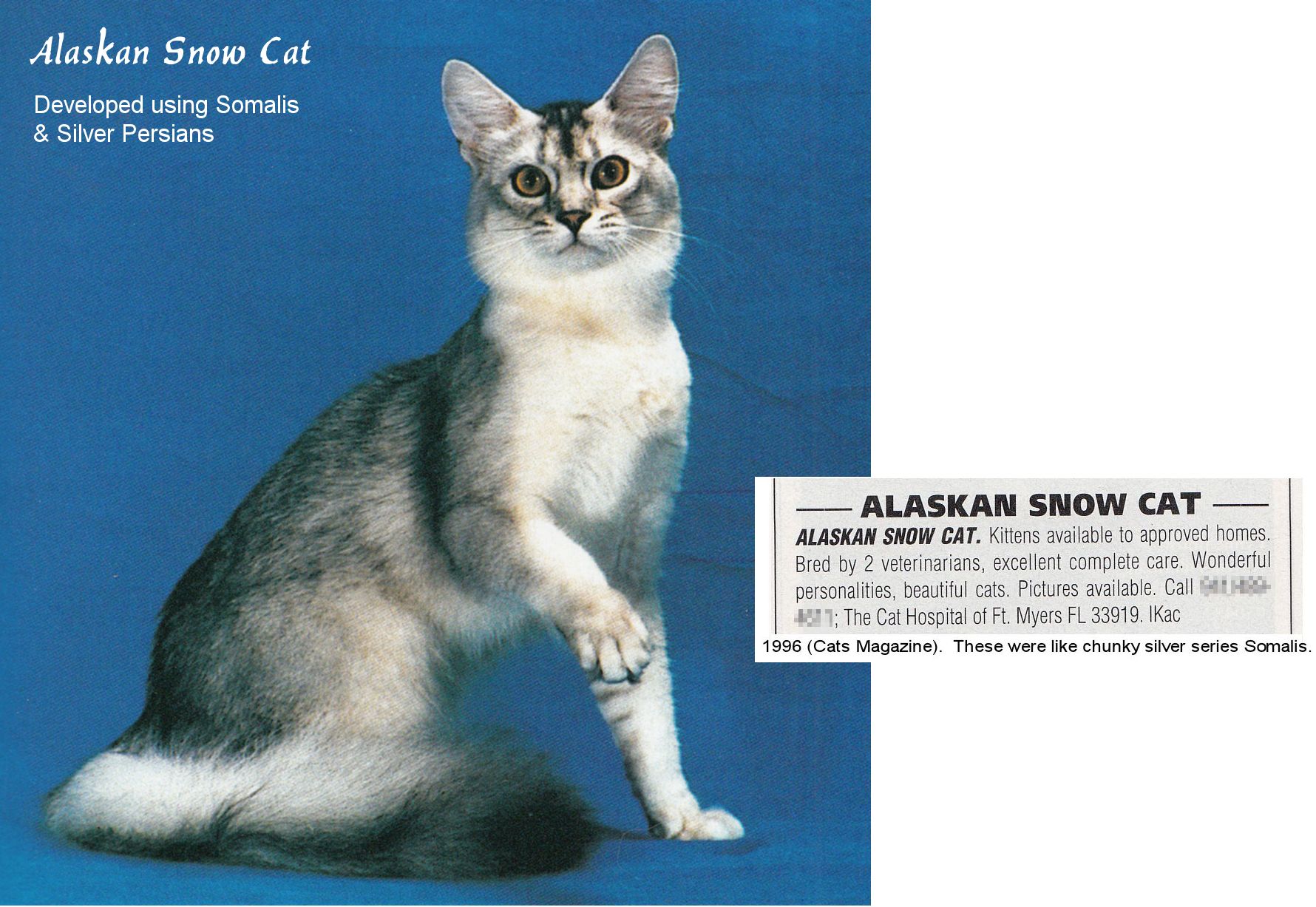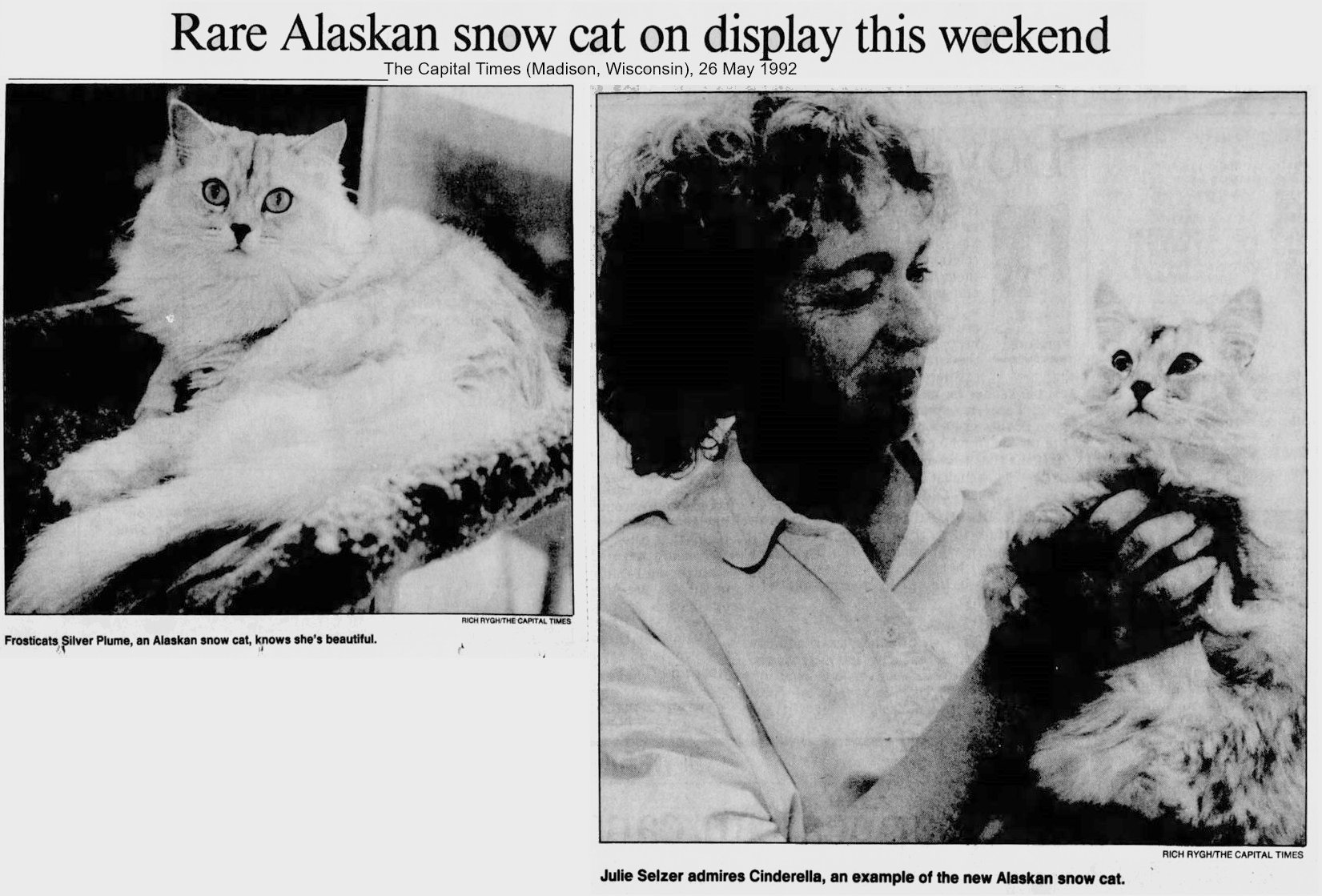
LOST BREEDS - ALASKAN SNOW CAT

The Alaskan Snow Cat was another experimental breed derived from the Somali; this time crossed to silver Persians. It was created in the 1990s by several breeders throughout the United States, and breeding was concentrated around Minnesota and Florida. The breeders were working towards creating a breed standard and gaining recognition of the breed. They aimed to produce a cat with the grace and beauty of the Somali, but with a heavier body and head through outcrossing to Persians.
The desired colours included a very pale or white underbelly, while the body colour was brown, rust (Somali red) or black (Somali ruddy), and most had residual dark banding on the legs and tail. The most desirable colour of the Alaskan Snow cat was a silver-grey with darker grey banding and a white underbelly and throat ruff - a colour familiar to European breeders of Somalis, but not then accepted in American Somalis, as "silver series". In terms of colour, breeders were reinventing the wheel. In terms of conformation, they heading along the same path as the Burmilla/Asian group of cats.
The Alaskan Snow Cat, due to its Persian ancestor, was bred to be stronger and more stable than the Somali. It was intended to be a good family pet; hardier than the Somali and more able to roughhouse with dogs and small children. Their cobbiness and weight meant they were less agile or acrobatic than the Somali. While they couldn't jump as nimbly or as high as A Somali, they were good climbers and liked high vantage points such as the tops of cupboards or bookshelves (and even curtains that could support their weight). From the Persian they got a laid back temperament, but they disliked loud or sudden noises. They were people-oriented and enjoyed the company of other family pets as well as the company of their own breed.
However, it was difficult to standardise the look and colour of the breed and it probably lost out to the silver series Somalis and the Burmilla/Asian cats whose traits were similar and which were already established breeds outside of North America.

Rare Alaskan Snow Cat on Display This Weekend (The Capital Times (Madison, Wisconsin), 26 May 1992)
"If you put rhinestone glasses on her and sent her to Miami Beach, she would think she'd died and gone to heaven." Julie Selzer was talking about a cat - a glamorous new kind of cat. The fledgling breed is called Alaskan snow cat, and Selzer, of Verona, is among the few people in the world who own these rare creatures.
The snow cat has the genes of three established breeds: Somali, a reddish-brown cat that resembles a long-haired Abyssinian; shaded silver Persian; and shaded silver American Shorthair. Imagine a silver fox - sparkling white with black-tipped fur, and emerald eyes outlined in black. That's the description of the Alaskan snow cat, which several Mid-western breeders have been developing since 1987. Exquisite, exotic, wild-looking are adjectives that fit these cats well. The color brings to mind a Siberian husky or Arctic fox.
"They're lovely, like a piece of jewelry - and they know it," Selzer says, adding that an Alaskan snow cat is likely to be "a real ham, with a sweet, friendly disposition."
Selzer plans to have her two snow cats on special exhibition at the Cats of Wisconsin club's annual show this Saturday and Sunday at the Dane County Expo Center Forum building. Although the cats are pedigreed (their ancestry is known and recorded), they still are considered an experimental breed and thus are not eligible to compete in shows. Alaskan snow cats come in four colors: ebony silver (black ticking on white), cinnamon silver (brown on white), blue silver (gray on white) and fawn silver (beige on white). Selzer's cats are ebony silver. Selzer had been involved in breeding horses and dogs on a small scale when she first saw an Alaskan Snow Cat at a show in Chicago and fell in love.
"I waited a year and a half for a kitten," she recalls. That now-grown kitten, Frosticats Silver Plume ("Silvi"), will be on display this weekend along with her daughter, Cinderella ("Cinder"). Silver Plume's breeder, Judy Legg of Palatine, Ill., originated the Alaskan Snow Cat. She explains that gaining official recognition for a new breed is a long, arduous process involving many breedings and careful record-keeping.
"We have years of work ahead, but we won't be daunted by that," she says. "The cats are gorgeous and we do want to be able to show them eventually."
So far about 40 Snow Cats have been born, she says, and about 15 to 20 of those have been used in breeding programs. Six breeders are working with them - four in the Midwest, one in Florida and one on the West Coast.
Legg remembers that when she first saw a shaded silver American Shorthair she said, "That doesn't even look real, it's so unusual." But she also loved the "wilder look" of the ruddy Somali, with its lynx-like ear tufts and bushy tail plume. "I wanted a Somali type with the shaded silver color" - and the idea for a new cat breed was born.
Selzer's lovestruck response when she first spotted an Alaskan snow cat apparently wasn't unusual. "Most people are extremely enthusiastic when they see these cats," the Verona resident says. "There's no question in my mind that when we finally get the breed established, we'll have something really cool."
Cool, in fact, like Alaska: beautiful, with a hint of the wild.
Reason for loss: most likely too similar to existing breeds